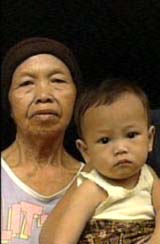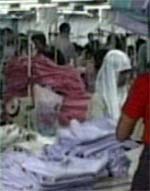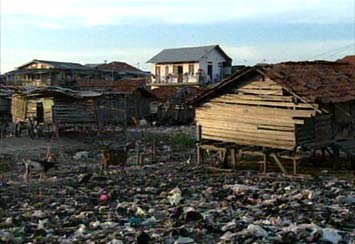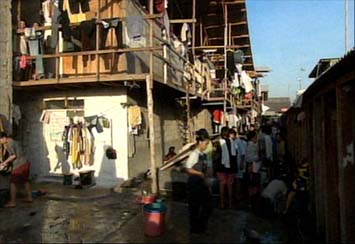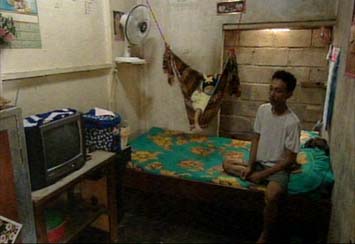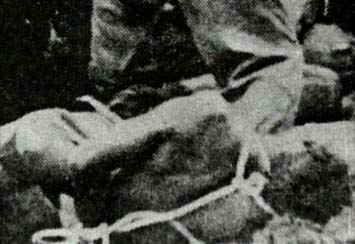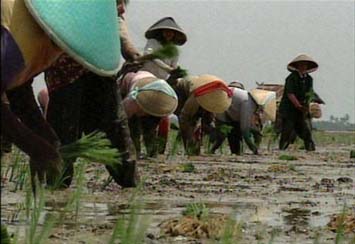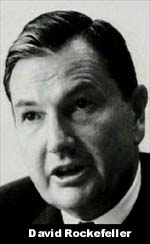
|
|
Globalisation in Indonesia: Spoils of a Massacre report by John Pilger,
In Indonesia 35 years ago, a military dictator took over, a million people were killed and a red carpet was rolled out for western capital. It was the start of globalisation in Asia, a model for the rest of the world, leaving a legacy of sweatshops and corruption. Flying into Jakarta, it is not difficult to imagine the city below fitting the World Bank's description of Indonesia. A "model pupil of globalisation" was the last of many laurels the bank bestowed. That was almost four years ago, in the summer of 1997. Within weeks, short-term global capital had fled the country, the stock market and currency had crashed, and the number of people living in absolute poverty had reached almost 70 million. The next year, General Suharto was forced to resign after 30 years as dictator, taking with him severance pay estimated at $15 billion, the equivalent of almost 13% of his country's foreign debt, much of it owed to the World Bank. From the air, it is the industrial design of the model pupil that is striking. Jakarta is ringed by vast compounds, known as economic processing zones. These enclose hundreds of factories that make products for foreign companies: the clothes you buy on the high street, from the cool khakis of Gap to the Nike, Adidas and Reebok trainers that sell in the UK for up to 100 pounds a pair. In these factories are thousands of mostly young women working for the equivalent of 72 pence per day.At current exchange rates, this is the official minimum wage in Indonesia, which, says the government, is about half the living wage and here, that means subsistence. Nike workers get about 4% of the retail price of the shoes they make - not enough to buy the laces. Still, they count themselves lucky: they have jobs. The "booming, dynamic economic success" (another World Bank accolade) has left more than 36 million without work
Clinging to the factories, like the debris of a great storm, are the labour camps: Hobbesian communities living in long dormitories made from breeze blocks, plywood packing cases and corrugated iron. Like the majority of humanity who are not touched by the delights of McDonald's and Starbucks, the internet and mobile phones, who cannot afford to eat enough protein, these are globalisation's unpeople. They live wit open, overflowing sewers and unsafe water for many, up to half their wages go on drinkable water. Through their homes run stinking canals dug by the former colonial masters, the Dutch, in the usual vainglorious attempt to recreate Europe in Asia. The result is an urban environmental disaster that breeds mosquitoes today, a plague of them in the camps has brought a virulent form of dengue fever, known as "break-back fever". After several visits here, I was bitten and took two months to recover. For the undernourished young children in the camps, however, dengue often means death. It is a disease of globalisation the mosquitoes domesticated as the camps grew and as the sweatshop workers migrated from rural areas, having been impoverished largely by World Bank programmes that promote export cash crops over self-sustaining agriculture.
I could just squeeze along a passageway. It was filled with people's clothes, hanging in plastic, like the backroom of a dry cleaner's. The cleanliness and neatness of people's lives is astonishing. They live in cell-like rooms, mostly without windows or ventilation, in which eating and sleeping are tuned to the ruthless rhythm of shiftwork in the factories. During the monsoon season, the canals rise and flood, and more plastic materialises to protect possessions: a precious tape player, posters of the Spice Girls and Che Guevera. I almost tipped over a frying pan of sizzling tofu. There are open paraffin fires and children darting perilously close. I watched a family of five perched on a patch of green, gazing at the sunset through a polluted yellow haze tiny bats circled overhead in the distance were the skeletal silhouettes of unfinished skyscrapers. It was an apocalyptic glimpse of a "globalised" world that Blair and Bush say is irreversible.
A code of conduct issued by the American company Gap says: "Dormitory facilities [must] meet all applicable laws and regulations related to health and safety, including fire safety, sanitation, risk protection and electrical, mechanical and structural safety." Because these dormitories are not on the factory site, however, Gap and the companies they contract to make their products are not liable. Consumers humming into Gap's numerous stores in Britain might reflect on this non-liability as they pay for smart shirts made by people who, on the wages they are paid, cannot afford even the buttons, let alone a decent place to live. Ten miles from the camps, along the toll road owned b Suharto's daughter (he distributed the national power grid among his children banks and vast tracts of forest were tossed to generals and other cronies), lies downtown Jakarta. This is the approved face of the global "model pupil". Here you can find McDonald's with sugar-plump children on Ronald's knee, and shopping malls with Versace leather coats at £2,000 and a showroom of Jaguar cars. One of the smartest hotels is the Shangri-la. There are four wedding receptions here every Sunday night. Last December, attended one that cost $120,000. It was held in the grand ballroom, which is a version of the ballroom of the Waldorf Astoria in New York, complete with chandeliers and gold-leaf arches. The guests wore Armani, Versace and real diamonds, and dropped cheques in a large box. There was an eight-tier cake with the initials of the couple embossed in icing and the holiday snaps of them on a world tour were projected cinema-size. The guests included former cronies of the deposed Suharto and the chief representative of the World Bank in Indonesia, Mark Baird, a New Zealander, who looked troubled when I asked him if he was enjoying himself. The World Bank says its mission in Indonesia is "poverty reduction" and "reaching out to the poor". The Bank set up the $86 million loan that built the Shangri-la, which, shortly after the wedding attended by Baird, sacked most of its workers when they went on strike for decent pay. The Gotham City skyline of downtown Jakarta is mostly banks, many of them empty, and unfinished buildings. Before 1997, there were more banks here than in any city on earth, but half of them have gone bust since the "dynamic" economy collapsed beneath the weight of its corruption. During Suharto's 30-year dictatorship, a cataract of "global" capital poured into Indonesia. The World Bank lavished more than $30 billion. Some of this went to worthwhile programmes, such as literacy, billions went elsewhere - $630 million was spent on a notorious "transmigration" programme that allowed Suharto to colonise the archipelago. Migrants from all over Indonesia were sent to occupied East Timor, where they controlled the economy. The recent blood-letting in Kalimantan (Borneo) was directed against Madura islanders who had been shipped in to "develop" the territory. In August 1997, an internal World Bank report, written in Jakarta, confirmed arguably the greatest scandal in the history of "development" - that "at least 20 to 30%" of the bank's loans "are diverted through informal payments to GOI [Government of Indonesia] staff and politicians". Seldom a month would pass when Suharto was not being congratulated by western politicians for bringing "stability" to the world's fourth most populous nation. British politicians were especially appreciative, beginning with Harold Wilson's foreign secretary, Michael Stewart, who in 1966 lauded the dictator's "sensible economic policies". Margaret Thatcher called Suharto "one of our very best and most valuable friends". John Major's foreign secretary, Douglas Hurd, championed the Suharto regime's "Asian values" (the unctuous code for lack of democracy and abuse of human rights). In 1997, Robin Cook's first trip abroad included Indonesia, where he shook hands warmly with Suharto - so warmly that a colour photograph of the pair of them was chosen, bizarrely, to illustrate the Foreign Office's report on human rights in the world. They all knew, of course. Amnesty filled cabinets with evidence of Suharto's grisly record. Milosevic and Saddam Hussein were wimps by comparison. Shortly before Cook flew in, an exhaustive investigation by the foreign affairs committee of the Australian parliament concluded that Suharto's troops had caused the deaths of "at least" 200,000 East Timorese, a third of the population. In New Labour's first year in office, Britain was the biggest weapons supplier to Indonesia.
This made sense - the arms trade is one of globalisation's great successes an Indonesia, the model pupil, has played a vital role. When the "global economy" (ie, unfettered capitalism) took hold in Britain in the early 80s, Margaret Thatcher set about dismantling much of Britain's manufacturing, while restoring the country's arms industry to a world leader, second only to the US. This was done with veiled subsidies, of the kind that underwrite and rig the "free market" in the west. Almost half of all research and development funds went on "defence" and the export credit guarantee department (ECGD) of the Department of Trade and Industry offered "soft loans" to third world regimes shopping for hi-tech sabres to rattle. That many had appalling human rights records and internal conflicts and/or were on the verge of war with a neighbour (India, Pakistan, Iran, Iraq, Israel) was not a barrier. Indonesia was a major recipient of these virtual giveaways. During one 12-month period, almost pounds 1 billion of ECGD money financed the sale of Hawk fighter-bombers to Indonesia. The British taxpayer paid up the arms industry reaped its profits. The Hawks were used to bomb villages in the mountains of East Timor - and the Foreign Office lied about for years, until Cook was forced to admit it. Since then, the Hawks have bombed the West Papuans as they have struggled to free themselves. I drove into the Krawang region of Java, where I met a rice farmer calle Sarkom. It is fair to describe Sarkom as representative of the 80% of humanity whose livelihoods depend on agriculture. He is not among the poorest, he lives with his wife and three daughters in a small, bamboo-walled house and there are tiles on the floor. At the front, under the eave, is a bamboo bed, a chair and a table where his wife, Cucuk, supplements their income with sewing. Last year, the International Monetary Fund offered the post-Suharto government a "rescue package" of multi-million-dollar loans. The conditions included the elimination of tariffs on staple foods. "Trade in all qualities of rice has been opened to general importers and exporters," decreed the IMF's letter of intent. Fertilisers and pesticides also lost their 70% subsidy. This means that farmers such as Sarkom are likely to go bankrupt and their children forced to find work in the cities. Moreover, it gives the green light to the giant US foodgrains corporations to move into Indonesia.
The double standard embodied in these conditions is breathtaking. Agribusiness in the west, especially in the US and Europe, has been able to produce its infamous surpluses and develop its export power only because of high tariff walls and massive domestic subsidies. The result has been the soaring power of the west over humanity's staples. The chief executive of the Cargill Corporation, which dominates the world trade in foodgrains, once boasted, "When we get up from the breakfast table each morning, much of what we have eaten - cereals, bread, coffee, sugar and so on - has passed through the hands of my company." Cargill's goal is to double in size every five to seven years. This is known as "free trade". "I went to prison for 14 years so that this would not happen," said Sarkom. "All my friends, those who were not killed, went to prison so that the power of big money would not take us over. I don't care what they call it now - global this or that. It's the same force, the same threat to our lives." That remark refers to a chapter in Indonesia's recent past that western politicians and businessmen would prefer to forget, although they have been among the chief beneficiaries. Sarkom was one of tens of thousands imprisoned when General Suharto seized power in Indonesia in 1965-66 - the "year of living dangerously" - deposing the nationalist president Sukarno, who had led Indonesia since the end of Dutch colonial rule. Scholars now estimate that as many as a million people died in a pogrom that was directed primarily at Indonesia's communist party, the PKI. Sarkom was 19 when he was taken away. He is trying to write down in an exercise book his memories of the horrors he experienced. He was for many years on Buru island, where thousands were dumped, at first without housing, food and water. On the day I went to see him, he had gathered a group of friends for me to meet, men in their 60s and 70s, who had also been tapols - political prisoners released since the fall of Suharto in 1998. Two were teachers, one a civil servant, another a member of parliament. One man was imprisoned because he refused to vote for Suharto's front party, Golkar. Several were PKI members. Adon Sutrisna, a teacher, told me, "We are the people, the nation, that the world forgot. If you know the truth about what happened in Indonesia, you can understand clearly where the world is being led today." A few miles from Sarkom's farm is a hump of earth overgrown with mustard flowers. It is a mass grave, but it has no markings - 35 years after the murders, the families of the victims, believed to be a dozen, are still too frightened to place a headstone. However, in the post-Suharto era, many Indonesians are slowly overcoming th fear that has blighted a generation throughout the countryside, families have begun to excavate the remains of their loved ones. They are furtive figures of the night, occasionally glimpsed on the rim of a paddy or a riverbank. The older witnesses recall rivers "jammed with bodies like logs" in village after village, young men were slaughtered for no reason, their murder marked by rows of severed penises. I have a friend in Jakarta whose name is Roy. Others call him Daniel. These are just two of many aliases that have helped keep him alive since 1965. He is one of a group of remarkable revolutionaries who went underground during the long years of Suharto's repression - the years when the World Bank was tutoring its "model pupil" - emerging at critical moments to lead spears of a clandestine opposition movement. On several occasions, this led to his arrest and torture. "I survived because they never knew it was me," he said. "Once, a torturer yelled at me, 'Tell us where Daniel is!' " In 1998, he helped bring on to the streets the students whose courageous confrontations with troops usin British-supplied anti-riot vehicles played a critical role in finally bringing down the dictator. Roy took me back to his primary school where, for him, the nightmare of Suharto's rule began. As we sat in an empty classroom, he recalled the day in October 1965 when he watched a gang burst in, drag the headmaster into the playground, and beat him to death. "He was a wonderful man: gentle and kind," Roy said. "He would sing to the class, and read to me. He was the person that I, as a boy, looked up to . . . I can hear his screams now, but for a long time, years in fact, all I could remember was running from the classroom, and running and running through the streets, not stopping. When they found me that evening, I was dumbstruck. For a whole year I couldn't speak." The headmaster was suspected of being a communist, and his murder that day was typical of the systematic executions of teachers, students, civil servants, peasant farmers. "In terms of the numbers killed," reported the Central Intelligence Agency, "the massacres rank as one of the worst mass murders of the 20th century." The historian Gabriel Kolko wrote that "the 'final solution' to the communist problem in Indonesia ranks as a crime of the same type as the Nazis perpetrated". According to the Asia specialist Peter Dale Scott, western politicians, diplomats, journalists and scholars, some with prominent western intelligence connections, propagated the myth that Suharto and the military had saved the nation's honour from an attempted coup by the Indonesian communist party, the PKI. Until then, Sukarno had relied on the communists as a counterweight to the army. When six army generals were murdered on September 30, 1965, Suharto blamed the PKI. Since the dictator's fall in 1998, witnesses have spoken for the first time and documents have come to light strongly suggesting that Suharto, who had military control of Jakarta, opportunistically exploited an internecine struggle within the army in order to seize power. What is also no longer in doubt is the collaboration of western governments and the subsequent role of western big business. Indeed, globalisation in Asia was conceived in this bloodbath. For Britain, the goal at the time was to protect its post-colonial interests in Malaysia, then threatened by "confrontation" with an "unstable" Sukarno - a 1964 Foreign Office file called for the "defence" of western interests in Southeast Asia, "a major producer of essential commodities. The region produces nearly 85% of the world's natural rubber, over 45% of the tin, 65% of the copra and 23% of the chromium ore." Of Indonesia, Richard Nixon wrote, "With its 100 million people and its 300-mile arc of islands containing the region's richest hoard of natural resources, Indonesia is the greatest prize in Southeast Asia." Sukarno was a populist as well as a nationalist, the founder of modern Indonesia and of the nonaligned movement of developing countries, which he hoped would forge a genuine "third way" between the spheres of the two superpowers. He could be a democrat and a demagogue. He encouraged mass trade unions and peasant, women's and cultural movements. Between 1959 and 1965, more than 15 million joined political parties or affiliated mass organisations that were encouragedto challenge British and US influence in the region. With three million members, the PKI was the largest communist party in the world outside the Soviet Union and China. According to the Australian historian Harold Crouch, "the PKI had won widespread support not as a revolutionary party but as an organisation defending the interests of the poor within the existing system". It was this popularity, rather than any armed insurgency, that alarmed the Americans. Indonesia, like Vietnam to the north, could "go communist". In 1990, the American investigative journalist Kathy Kadane revealed the extent of secret US collaboration in the massacres of 1965/66 that toppled Sukarno and brought to power Suharto, who at the time was little known outside western intelligence circles. In a series of interviews with former US officials, she concluded, "They systematically compiled comprehensive lists of communist operatives. As many as 5,000 names were furnished to the Indonesian army, and the Americans later checked off the names of those who had been killed or captured." In 1966, the US ambassador in Jakarta assured Suharto that the "US is generally sympathetic with and admiring of what the army is doing". The British ambassador, Sir Andrew Gilchrist, reported to the Foreign Office: "I have never concealed from you my belief that a little shooting in Indonesia would be an essential preliminary to effective change." Having already armed and equipped much of the army, Washington secretly supplied Suharto's troops with a field communications network. Flown in at night by US Air Force planes from the Philippines, this was state-of-the-art equipment, whose high frequencies were known to the CIA and the National Security Agency. Not only did this technology allow Suharto's generals to coordinate the killings, it also meant that the highest echelons of the US administration were listening in. Suharto was able to seal off large areas of the country. Archive film of people being herded into trucks and driven away exists but that is all. To my knowledge, the fuzzy photograph published here is the only pictorial record of the actual killings in this Asian holocaust. It ought to be salutary for journalists these days to heed the important role that western propaganda played then, as it does now. British intelligence manipulated the press so expertly that Norman Reddaway, head of the Foreign Office's Information Research Department (IRD), boasted to Ambassador Gilchrist, in a letter marked "secret and personal", that the spin he and his colleagues had orchestrated - that Sukarno's continued rule would lead to a communist takeover - "went all over the world and back again". He describes an experienced Fleet Street journalist agreeing "to give your angle on events in his article . . . ie, that this was a kid-glove coup without butchery". Roland Challis, who was the BBC's Southeast Asia correspondent at the time, believes that the cover-up of the massacres was a triumph for western propaganda. "My British sources purported not to know what was going on," he told me, "but they knew what the American plan was. There were bodies being washed up on the lawns of the British consulate in Surabayo, and British warships escorted a ship full of Indonesian troops down the Malacca Straits, so that they could take part in this terrible holocaust. It was only much later that we learned the American embassy was supplying names and ticking them off as they were killed. There was a deal, you see. In establishing the Suharto regime, the involvement of the IMF and the World Bank was part of it. Sukarno had kicked them out now Suharto would bring them back. That was the deal." With an ailing Sukarno powerless and Suharto about to appoint himself president, the US press reported the Washington-backed coup not as a great human catastrophe but in terms of the new economic advantages. The military takeover, notwithstanding the massacres, was described by Time magazine as "The West's Best News in Asia". A headline in US News and World Report read: "Indonesia: Hope . . . where there was once none." The renowned New York Times columnist James Reston celebrated "A gleam of light in Asia" and wrote a kid-glove version he had clearly been given. The Australian prime minister, Harold Holt, who was visiting the US, offered a striking example of his sense of humour: "With 500,000 to a million communist sympathisers knocked off," he said, "I think it's safe to assume a reorientation has taken place." Ralph McGehee, a senior CIA operations officer at the time, whom I first interviewed almost 20 years ago, described the ousting of Sukarno in Indonesia as a "model operation" for the US-run coup that got rid of Salvador Allende in Chile seven years later. "The CIA forged a document purporting to reveal a leftist plot to murder Chilean military leaders," he wrote, "[just like] what happened in Indonesia in 1965." He says the Indonesian massacres were also the model for Operation Phoenix in Vietnam, where US-directed death squads assassinated up to 50,000 people. In November 1967, following the capture of the "greatest prize", the booty was handed out. The Time-Life Corporation sponsored an extraordinary conference in Geneva which, in the course of a week, designed the corporate takeover of Indonesia.
Across the table were Suharto's men, whom Rockefeller called "Indonesia's top economic team". Several were economists trained at the University of California in Berkeley. All sang for their supper, offering the principal selling points of their country and their people: "Abundance of cheap labour . . . a treasure house of resources . . . a captive market." Recently, I asked one of them, Dr Emile Salim, if anyone at the conference had even mentioned that a million people had died in bringing this new business-friendly government to power. "No, that was not on the agenda," he replied. "I didn't know about it till later. Remember, we didn't have television and the telephones were not working well." The Indonesian economy was carved up, sector by sector, at the conference. In one room, forests in another, minerals. The Freeport Company got a mountain of copper in West Papua (Henry Kissinger is currently on the board). A US/European consortium got West Papua's nickel. The giant Alcoa company got the biggest slice of Indonesia's bauxite. A group of US, Japanese and French got thetropical forests of Sumatra, West Papua and Kalimantan. A Foreign Investment Law, hurried on to the statutes by Suharto,
made this plunder tax-free for at least five years. Real, and
secret, control of the Indonesian economy passed to the IMF
and the World Bank through the Inter-Governmental Group on Indonesia
(IGGI), whose principal members were the US, Canada, Europe
and Australia. Under Sukarno, Indonesia had few debts. Now the
really big loans rolled in, often straight into pockets, as
the treasurehouse of resources rolled out. Shortly before the
Asian financial crash in 1997, the IGGI godfathers congratulated
their favourite mass murderer for having "created a miracle
economy.
© copyright John Pilger.
|
